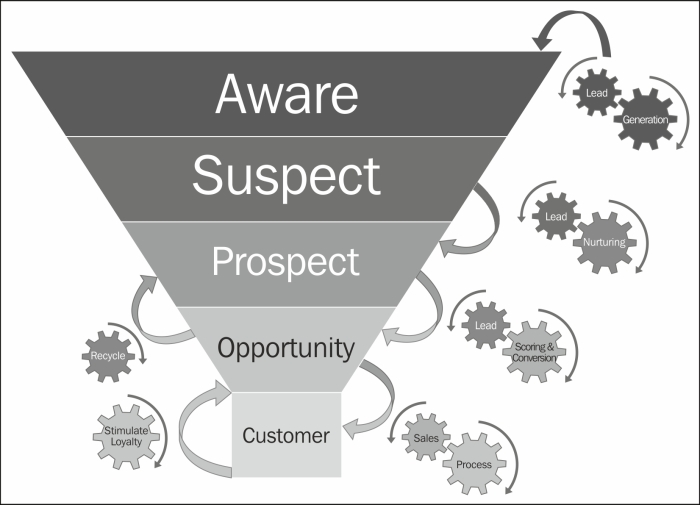Present day businesses understand the importance of target marketing and have started moving away from mass marketing. Target marketing requires an effective lead management strategy that can help move the leads through different phases and nurture them until they are ready to buy. Once the leads are qualified and ready to interact with the sales, leads move to the sales process by the creation of an opportunity that eventually results in a customer if the opportunity is won.
CRM not only provides effective lead management, but also uses its powerful data visualization to render a lead funnel that provides visibility into the progression of a lead in the system from generation to customer creation, along with potential revenue for each stage, fallout at every stage, and the rate of fallout.
Lead funnel is a key strategy for marketers, and it can help businesses focus on the most likely leads and effectively manage them. A typical lead funnel with various stages and corresponding processes involved in progression from one stage to the next is shown in the following figure:

Lead funnel showing various stages
We will now explore each of the stages and the processes involved in the progression of a lead into a customer.
The wide area of the funnel corresponds to the lead generation that is the input to the funnel. The lead generation strategy is critical to provide high volume of leads and fill the wide upper-end of the funnel. Some of the lead generation strategies used are tracking the visitors to your website, tracking the suspects who download free white papers and e-books from your website, joining trade shows, organizing webinars and podcasts, keeping records of the attendees and viewers, having a business blog to showcase your upcoming products to create interest and excitement, and having a social media strategy. Most importantly, the quality of leads generated directly depends on the quality and the relevance of the content for your target audience. Lead generation provides a hint that the person might be a target, with basic information such as the name and the demographic information, and based on some additional interests shown by the person, they can be promoted to a suspect for the nurturing process.
Most of the new leads will not be ready to engage because the willingness to buy need not coincide with your readiness to sell. Lead nurturing is a process of building relationship with the suspect who has shown interest in the product so that they become ready to be engaged by the sales team. This involves various actions to build a relationship and establish connection with the customer by providing the right amount of targeted information at the right intervals to educate the suspect and create demand for the product. Lead nurturing can involve drip marketing to include a series of e-mails offering educational content and promotional giveaways to build interest. The nurturing process should create credibility and trust for your company and products. This can be achieved by being a trusted advisor and a thought leader who provides useful information to make the right decisions for your customers.
The sales and marketing teams together come up with a methodology for lead scoring to determine if the lead is sales ready. Scoring can be a manual or automated process that takes into consideration the interest shown by the lead in your product to assign points to a prospect and ranks them as cold, warm, and hot. When the prospect rank reaches an agreed threshold, it is considered to be qualified and is assigned to the sales team after acceptance by sales. The process of lead scoring can vary from company to company, but some of the general criteria used for scoring are the demography, expense budget, company size, industry, role and designation of the lead contact, and profile completeness. In addition, scoring also take into consideration various behavioral characteristics to measure the frequency and quality of engagement, such as the response to e-mail and contacts, number of visits to website, the pages visited, app downloads, and following on social media. Lead scoring is a critical process that helps align the sales and the marketing teams within the organization by passing quality leads to the sales team and making the sales effective.
Once a lead is accepted by the sales, it is qualified as an opportunity that the sales team will pursue until it is won or lost. A lost opportunity may not be as much of a loss as it is deemed to be. The lost opportunities can be once again recycled back to a lead that can undergo further nurturing to be ready for the sales team again sometime down the road.
Once we have won an opportunity to get our new customer, the funnel is considered complete. However, it brings an additional layer of responsibility that is often missed. The responsibility to retain the customer by continuous customer delight, which will stimulate loyalty and evolve customers into advocates who will in turn spread the word. In the marketing world, this is also referred as zero dollar marketing! Customer delight is not just about selling the best product, but also about the overall experience of the customer, which involves excellent customer service. Most importantly, listen to your customer and let them know how much you care for them.
"Make a customer, not a sale" | ||
| --– Katherine Barchetti | ||
